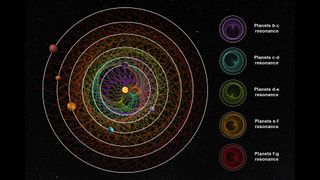6 alien worlds have been 'waltzing' in perfect rhythm for 4 billion years
Six exoplanets with sizes between Earth and Neptune have been in rhythm with each other since they were born around the same star 4 billion years ago, new research suggests.

Astronomers have discovered a remarkable star system with six planets unlike any in our solar system. According to new research, all six planets orbit the same star in resonance with each other, following an unwavering rhythm that has lasted billions of years.
Because of this peculiar resonance, the outermost planet in the system completes one full orbit of its star in the same time it takes the innermost planet to complete six orbits. The remaining four planets follow similar rhythmic patterns, moving in what the researchers call a precise cosmic "waltz."
Details about the peculiar system, named HD 110067, were published Nov. 29 in the journal Nature.
"The HD 110067 system is remarkable for a few reasons," study co-author Hugh Osborn, a scientist at the University of Bern, told Live Science in an email. "The first is that all six planets have orbits that are perfectly tuned to each other in a so-called resonance, which is rare. The second is that the star is so bright. It's the brightest star yet discovered to host more than four transiting planets."
Related: Astronomers spot violent afterglow of 2 massive planets that collided in a distant star system
Investigating a peaceful planetary system

The six extrasolar planets, or exoplanets, orbit a bright-yellow star located around 100 light-years from Earth in the constellation Coma Berenices. These distant worlds have widths between that of Earth and the ice giant Neptune, making them mini-Neptunes or "sub-Neptunes."
Though sub-Neptunes are the most common planets in the Milky Way, worlds of this size are absent from the solar system. Therefore, the HD 110067 system could help astronomers study how exoplanets like this evolve and why the solar system lacks sub-Neptunes.
The fact that the six planets are still rhythmically linked tells scientists a great deal about the peaceful existence they have enjoyed thus far. This is because when collapsing clouds of gas and dust around infant stars create planets, these proto-worlds are often in resonance, but violent events wipe out this rhythm.
"We know that these resonances form while the planets are forming, so this means that the planets must have remained pretty much unchanged — with no orbital shuffling, collisions, or mass loss for billions of years," Osborn explained.
The team began investigating this system in detail in 2020, when observations made with NASA's Transiting Exoplanet Survey Satellite (TESS) showed a dip in light of the star HD 110067 that indicated an undiscovered planet was crossing — or "transiting" — its face, blocking some of its light as seen from Earth.
Following this observation, TESS detected several more dips, prompting the team to look more closely with the Characterising Exoplanet Satellite (CHEOPS), which revealed that the signals were from six planets, all transiting the face of their star — a rare arrangement indeed.
"With the data we had from TESS and CHEOPS alone, the orbits of the outer three planets were unknown," Osborn said. "But because we saw they were in a resonance chain, this allowed us to perfectly predict their orbits, with later observations revealing that our predictions were correct. That's the first time these resonances have been instrumental in discovering new planets."
The resonance means the closest world to the star completes an orbit in 9.1 Earth days, the next planet out orbits in 13.6 days, the third in 20.5 days, the fourth in 30.8 days, the fifth in 41 days, and the outermost planet in 54.7 days. So, for every orbit of the outer star, the inner star completes six orbits — a 6:1 resonance. The other resonances between different pairs of planets in the system are 3:2, 3:2, 3:2, 4:3 and 4:3.
Planets with rhythm and more
In addition to this resonance, the planets of the HD 110067 are interesting in their own right, lead study author Rafael Luque, an astronomer at the University of Chicago, noted at a news conference Tuesday (Nov. 28).
He said the planets are two to three times the diameter of Earth. And while the team isn't entirely sure of the planets' compositions, they seem to be made of ice or rock, with low densities that point to extended atmospheres of hydrogen and helium. There may even be more planets orbiting HD 110067.
Because all of the planets pass in front of their star and this star is so bright, these worlds have been some of the easiest exoplanets to characterize. These kinds of systems are "worth their weight in gold," Osborn said, and he is certain that the James Webb Space Telescope will soon be able to observe their planetary atmospheres, potentially detecting molecules such as methane, which could indicate underlying oceans.
Sign up for the Live Science daily newsletter now
Get the world’s most fascinating discoveries delivered straight to your inbox.
Robert Lea is a science journalist in the U.K. who specializes in science, space, physics, astronomy, astrophysics, cosmology, quantum mechanics and technology. Rob's articles have been published in Physics World, New Scientist, Astronomy Magazine, All About Space and ZME Science. He also writes about science communication for Elsevier and the European Journal of Physics. Rob holds a bachelor of science degree in physics and astronomy from the U.K.’s Open University
Most Popular

By Harry Baker

By Deepa Jain

By Tom Metcalfe

By Deepa Jain
